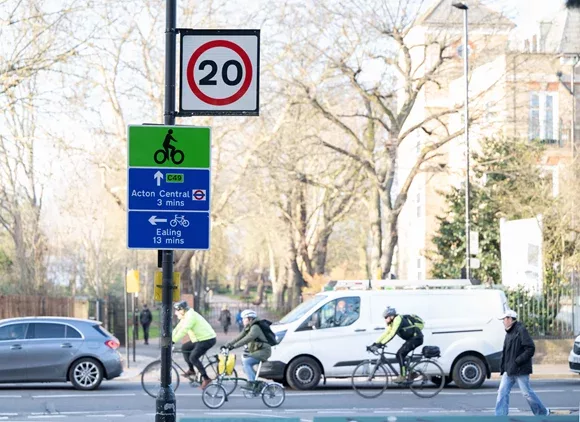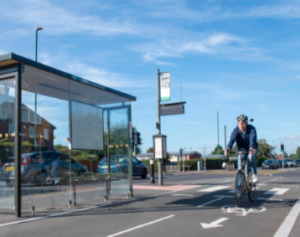Transport for London has launched three new Cycleways across the capital, which it says will make it even easier for people to travel around London by bike.
These new routes, the first of a series to be launched mainly using new low traffic local streets, are being delivered alongside TfL and the boroughs’ existing programme to build new walking and cycling infrastructure and will help to connect even more of London’s communities by cycle. It says this approach will see over 124,000 more Londoners within 400m of a high-quality cycle route, contributing to the Mayor’s target of 70 per cent of Londoners living within 400m of a high quality cycle network by 2041.
By the summer, this accelerated programme of Cycleways will help connect outer London town centres such as Lewisham, Wanstead, Edmonton Green and Brentford to the Cycleway network, unlocking cycling to many thousands of new residents and improving access to walking and cycling amongst traditionally underrepresented groups. Cycleways play a vital role in helping people to cycle accessing jobs, schools and hospitality in a healthy and sustainable way.
Three new Cycleways are launching today and further routes are planned to open this summer in Enfield, Hammersmith & Fulham, Barking & Dagenham and Redbridge. The new routes are:
- Cycleway 11 – a 3km route between Angel and Farringdon, connecting to C6 (Kentish Town to Elephant & Castle), C13 (Hackney Central to City), and C27 (East Acton to Walthamstow). Prior to the launch, cycling levels increased by 53 per cent between 2021 and 2022
- Cycleway 48 – a 3km route between Herne Hill and Clapham via Brixton, connecting to CS7 (Colliers Wood to City). Cycling on this route has nearly doubled between 2019 and 2021
- Cycleway 49 – a 4km route between Chiswick. Acton Central and North Acton, connecting to C9 (Kew Bridge to Hammersmith) C27 (East Acton to Walthamstow) and C34 (North Acton to Wood Lane). Cycling on this route has seen a near fourfold increase between 2019 and 2021
Will Norman, London’s Walking and Cycling Commissioner said: “The vital action many London’s boroughs have taken in reducing traffic on residential roads and lowering speed limits has enabled us to deliver these three new Cycleways at pace, unlocking access to cycling for many thousands of residents.
“These routes, mainly on low traffic streets, will not only connect communities but crucially improve access to cycling amongst traditionally underrepresented groups. Cycleways play an important role in encouraging more Londoners to walk and cycle, contributing to a greener, fairer city for all Londoners.”
Helen Cansick, TfL’s Head of Healthy Streets Investment, said: “I’m delighted that we are launching these Cycleway routes today, unlocking safe cycling to communities across London. These new routes are already popular and we expect cycling to grow further as people realise that cycling is now a healthy, cheap and sustainable option for them to make local journeys. Working alongside the boroughs, we’re committed to growing our Cycleways network to reach even more people in the capital and these routes, alongside the work we’re doing to transform major roads and junctions, will make a real difference to people travelling by bike.”
Cllr Rezina Chowdhury, Lambeth’s cabinet member for Sustainable Lambeth and Clean Air, said: “This speeded up program of new Cycleways is very welcome news because it will help people access cleaner, cheaper and healthier transport. This new route through Lambeth is possible due to the permanent Railton Low Traffic Neighbourhood and supports our concerted efforts to make our borough fairer and fit for the future. Our most disadvantaged communities suffer most from poor air quality and poor health outcomes.
“Our car dominated streets deny people with disabilities the opportunity to move around their area safely and with confidence, children opportunities to play and present serious danger with hundreds of people killed and seriously injured in collisions every year. New Cycleways, such as the route between Herne Hill and Clapham via Brixton, therefore support our wider ambitions to re-balance our neighbourhoods.”
Cllr Rowena Champion, Islington Council’s Executive Member for Environment, Air Quality, and Transport, said: “In Islington, we’re determined to create a more environmentally-friendly future, where local people can harness the environmental, physical, mental, and financial benefits of walking, cycling, and wheeling. As part of this we’re committed to working with TfL, and we’re delighted to have supported them with the delivery of Cycleway 11. The route will make it easier to travel between Angel and Farringdon, while connecting with other popular cycle routes.”
TfL announced last autumn that it will restart work on paused schemes to make the capital’s roads safer and more attractive for those walking and cycling, following vital investment being secured as part of the latest funding agreement with Government. Since April last year, TfL and boroughs have delivered 14.6km of new or upgraded cycle routes and there are a further 13.9km in construction. In total, TfL aims to deliver at least 39km of new or upgraded cycle routes over the next 18 months, with the support of boroughs.
TfL’s funding agreement with Government secured £80m per year to be invested in walking and cycling schemes, with a further £69m per year allocated to boroughs. TfL has so far reduced danger at 43 junctions across London as part of its Safer Junctions programme, with work on at a further two locations set to start this year. All locations in the Safer Junctions programme had higher-than-average collision rates and this improvement work is a vital part of TfL’s Vision Zero ambition.
TfL recently launched local engagement on plans to introduce 28km of new 20mph speed limit on its roads within the boroughs of Camden, Islington, Hackney, Haringey and Tower Hamlets. The new speed limits would help to make a large area of London safer and more attractive for people in these communities to live, work and play, encouraging more people out of their cars to walk, cycle and use public transport.
(Picture – TfL)






















